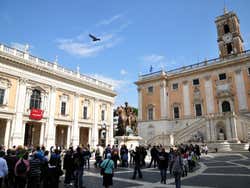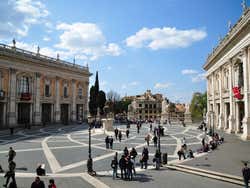
Piazza del Campidoglio
The Piazza del Campidoglio was laid down on the summit of the Capitoline Hill, the most important of Rome’s seven hills. It is the first modern square to be designed in Rome.
The piazza came about because Charles V, Holy Roman Emperor, organized a visit to Rome in 1536. Pope Paul III was so dismayed by the state of the sodden Capitoline Hill that he commissioned Michelangelo to design a square.
The design of the square
Michelangelo wanted the square to face St Peter’s Basilica, the political centre of Rome, instead of the Roman Forum. He also proposed the construction of another palace, Palazzo Nuovo, which would face Palazzo dei Conservatori. This palace, in its turn, would have a new façade. The Palazzo Senatorio’s front would also be redesigned so that all the buildings and the square would work harmoniously.
An imposing bronze equestrian statue of Marcus Aurelius was erected in the centre of the square. It is currently housed in the Palazzo dei Conservatori and in the square stands a replica of the Roman Emperor instead.
The execution of the plans took so long that Michelangelo didn’t live to see his work completed. Nevertheless, his designs were followed meticulously and finished several centuries later.
Twenty-first century Piazza del Campidoglio
The Piazza del Campidoglio is one of the most beautiful squares in Rome, attracting millions of visitors every year. Its popularity is also due to its proximity to the Capitoline Museums and the legendary sculpture of the Capitoline Wolf, situated between the Palazzo Senatorio and Palazzo Nuovo.
The bronze she-wolf on top of the column is a replica. The original is housed in the Capitoline Museums.


Nearby places
Capitoline Museums (13 m) Santa Maria in Aracoeli (101 m) Altare della Patria (142 m) Palazzo Venezia (297 m) Roman Forum (335 m)

